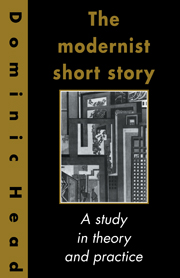Book contents
- Frontmatter
- Contents
- Preface
- Acknowledgements
- 1 The short story: theories and definitions
- 2 James Joyce: the non-epiphany principle
- 3 Virginia Woolf: experiments in genre
- 4 Katherine Mansfield: the impersonal short story
- 5 Wyndham Lewis: the Vorticist short story
- 6 Malcolm Lowry: expanding circles
- 7 Conclusion: contemporary issues
- Notes
- Bibliography
- Index
2 - James Joyce: the non-epiphany principle
Published online by Cambridge University Press: 06 July 2010
- Frontmatter
- Contents
- Preface
- Acknowledgements
- 1 The short story: theories and definitions
- 2 James Joyce: the non-epiphany principle
- 3 Virginia Woolf: experiments in genre
- 4 Katherine Mansfield: the impersonal short story
- 5 Wyndham Lewis: the Vorticist short story
- 6 Malcolm Lowry: expanding circles
- 7 Conclusion: contemporary issues
- Notes
- Bibliography
- Index
Summary
The stories in Dubliners illustrate very well the difficulties outlined in the previous chapter. Critical work on the book has tended to make the same mistaken emphases that pervade general short story theory: a focus on visual metaphor and on simplified symbolic effects are the main elements of a predominant, reunifying reading of Dubliners. Much critical effort has been expended on removing the ambiguities caused by ellipsis in Joyce's stories, and on locating key epiphanic moments. These two elements – ellipsis and epiphany – are indeed seminal to an understanding of Dubliners, but they are made problematic in Joyce's story technique, and cannot be viewed as pointers to a simple, unified meaning.
Although ambiguity is an integral aspect of Dubliners, much of the critical literature on the collection has served to obscure this fact. Of course, the Joyce industry has produced a vast and heterogeneous body of readings of all the major texts, but there is still a conventional reading of Dubliners which remains influential, especially for short story critics: a palpable unanimity of opinion has emerged with regard to the book's corporate ‘message’.
This orthodox approach views the stories, prior to the composition of ‘The Dead’, as studies in the spiritual paralysis of a modern city. The final story, it is often argued, ‘transforms the nature of the book’ through an empathic tone which, though ambivalent, modifies the detached cynicism of the earlier pieces.
- Type
- Chapter
- Information
- The Modernist Short StoryA Study in Theory and Practice, pp. 37 - 78Publisher: Cambridge University PressPrint publication year: 1992



